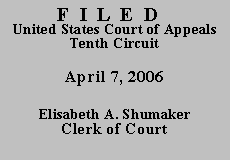 UNITED STATES COURT OF APPEALS
UNITED STATES COURT OF APPEALS
 UNITED STATES COURT OF APPEALS
UNITED STATES COURT OF APPEALS
| In re: CLARENCE JOSEPH EBEL,
JR.,
Debtor, _______________________________ CLARENCE JOSEPH EBEL, JR., |
|
| Appellant, | |
| v. | |
| DENNIS W. KING, Trustee, | |
| Appellee. |
This case has a procedural history that is "to put it mildly, long and tortuous." Order and Memorandum of Decision, 1 (D. Colo. Mar. 11, 2005). Debtor, Mr. Ebel, and his former wife commenced a divorce action in the Boulder County District Court in 1985, since which time the parties have been in constant litigation. See In re Ebel, No. 96-1190, 1997 WL 428574, at *1-*4 (10th Cir. July 30, 1997) (describing the case's history); Order, 1-9 (same). This particular appeal concerns the bankruptcy court's approval of a settlement agreement between the former Mrs. Ebel and the trustee in Mr. Ebel's bankruptcy case.
At the time of their divorce, the Ebels owned as tenants in common a nine-hole golf course, a driving range, an adjoining house, and three nearby building lots ("Property"). Since 1987 the Property has been managed by a receiver pending final resolution of the marital property, and earnings derived from the operation of the Property were divided 50/50 between the parties. In 1990, and before a final resolution of the Property could be made, Mr. Ebel filed for bankruptcy. Colorado courts have twice considered the division of the Property and twice awarded the former Mrs. Ebel all the Property, most recently in December 1999. In June 1996, the former Mrs. Ebel reached a settlement agreement with the trustee in Mr. Ebel's bankruptcy case that would end litigation regarding any claims that Mr. Ebel's estate might have on the Property or its proceeds. In April 2004, the bankruptcy court approved the settlement agreement and in March 2005, the district court affirmed the agreement.
Mr. Ebel makes three challenges to the bankruptcy court's approval of the settlement, each of which he made to the district court. First, Mr. Ebel claims that the settlement agreement is invalid because his share of the proceeds from the Property following his 1990 bankruptcy filing does not belong to the estate under 11 U.S.C. § 541(a)(6). Second, Mr. Ebel argues that the bankruptcy court did not follow Federal Rule of Bankruptcy Procedure 9019. And finally, Mr. Ebel argues that the bankruptcy court did not make the findings required by the rules of civil and bankruptcy procedure to accept a settlement agreement. The district court thoroughly addressed and rejected each of these arguments.
Mr. Ebel's work on the Property did not exempt proceeds from the Property from the bankruptcy estate. Section 541(a)(6) provides that an estate does not include "earnings from services performed by an individual debtor after the commencement of the case." The district court noted two problems with Mr. Ebel's argument that his share of proceeds from the Property is exempt from the estate. First, "it does not appear that [Mr. Ebel] adequately raised this issue in the proceedings below." Order, 11. Second, "there is no evidence that the receiver's payments were for [Mr. Ebel's] post-petition work." Id. at 12.
Mr. Ebel also argues that the bankruptcy court failed to follow the bankruptcy rules of procedure and, therefore, the settlement is void. Bankruptcy Rule 9019(a) states that "on motion by the trustee and after notice and a hearing, the court may approve a compromise or settlement" and requires that notice be given to the "creditors, the United States trustee, the debtor, and indenture trustees . . . ." In dismissing Mr. Ebel's argument, the district court explained that the bankruptcy court "(1) held a hearing, (2) of which [Mr. Ebel] and his creditors had notice, and (3) considered the probable success of the litigation on the merits, potential difficulties in collecting the judgment, the complexity and expense of the litigation, and the lack of objections by other creditors." Order, 13. The bankruptcy court's actions complied with Rule 9019. See In re Kaiser Steel Corp., 105 B.R. 971, 976-77 (D. Colo. 1989).
Finally, Mr. Ebel argues that the bankruptcy court failed to make the findings required to support acceptance of a settlement agreement. The bankruptcy court, however, "made all the findings necessary in a Rule 9019 hearing." Order, 14. Additionally, the bankruptcy court's findings were "sufficient to indicate the factual basis for the court's general conclusion as to the ultimate facts" and allowed for "meaningful review" of the issues." Otero v. Mesa County Valley Sch. Dist., 568 F.2d 1312, 1316 (10th Cir. 1977).
We have carefully reviewed the briefs, the district court's opinion, and the record. For substantially the same reasons laid out by the district court in its March 11, 2005 Order and Memorandum of Decision, we AFFIRM the
bankruptcy court's acceptance of the July 1996 settlement between the former Mrs. Ebel and the trustee. Entered for the Court
Monroe G. McKay
Circuit Judge
*. This order and judgment is not binding precedent, except under the doctrines of law of the case, res judicata, and collateral estoppel. The court generally disfavors the citation of orders and judgments; nevertheless, an order and judgment may be cited under the terms and conditions of 10th Cir. R. 36.3.